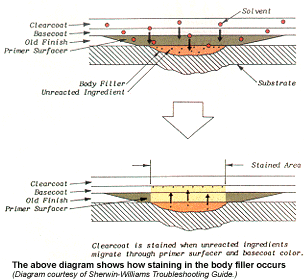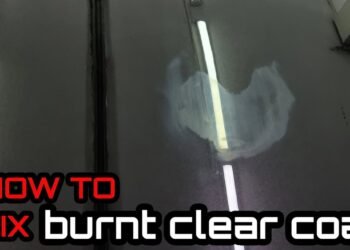Are you wondering if you can apply Bondo over primer without causing problems? This is a common question for anyone tackling car repairs or DIY projects.
Getting it wrong could mean your repair doesn’t last or ends up looking rough. But here’s the good news: with the right steps and preparation, you can confidently use Bondo over primer and achieve a smooth, durable finish. You’ll learn exactly when and how to apply Bondo over primer, so your repair sticks strong and looks professional.
Keep reading to avoid costly mistakes and master this essential technique.

Credit: www.reddit.com
Bondo And Primer Basics
Bondo and primer are essential materials in auto body repair and DIY projects. Understanding their basics helps you achieve a smooth, lasting finish. This section explains what Bondo is, the types of primer, and how Bondo bonds to surfaces.
What Is Bondo
Bondo is a popular body filler used to repair dents and holes in metal, plastic, and wood. It is a two-part putty that hardens quickly when mixed. After curing, it can be sanded, shaped, and painted over. Bondo fills imperfections and creates a smooth surface ready for painting.
Types Of Primer
Primer prepares the surface for paint and improves adhesion. There are different types, such as epoxy primer, high-build primer, and etching primer. Epoxy primer seals bare metal and protects against rust. High-build primer fills small scratches and helps with sanding. Etching primer bonds directly to metal, offering corrosion resistance.
How Bondo Bonds
Bondo sticks best to clean, dry, and roughened surfaces. It bonds mechanically by gripping into tiny surface pores. Primer creates a stable base for Bondo to adhere. Applying Bondo over the right primer ensures strong adhesion and prevents peeling. Proper surface prep is key to a durable repair.
Applying Bondo Over Primer
Applying Bondo over primer is a common step in automotive and surface repair projects. It helps create a smooth, even surface before painting. Understanding how to apply Bondo correctly over primer ensures strong adhesion and lasting results.
Suitable Primer Types
Not all primers work well with Bondo. Epoxy primers are ideal because they seal metal and resist moisture. High-build primers also provide a thick, smooth base for Bondo application. Avoid using lacquer or enamel primers since Bondo may not stick properly to them.
Surface Preparation Steps
Start by cleaning the primed surface thoroughly. Remove dust, grease, and oils using a suitable cleaner. Next, sand the primer with 180-220 grit sandpaper to create a rough texture. This sanding improves the grip between primer and Bondo. Wipe away sanding dust with a clean cloth before applying filler.
Techniques For Strong Adhesion
Mix Bondo following the manufacturer’s instructions carefully. Apply it in thin layers rather than thick ones for better control. Press the Bondo firmly onto the primed surface. Let each layer cure completely before sanding or adding more filler. Lightly sanding between layers helps the next layer bond well. Proper curing time and surface texture ensure a durable, smooth finish.
Primer Before Or After Bondo
Deciding whether to apply primer before or after Bondo is key for a lasting repair. The order affects adhesion, rust protection, and finish quality. Both methods have specific uses depending on the project needs and surface condition.
Reasons To Prime Before Filler
Priming before applying Bondo helps prevent rust on bare metal. Epoxy primers seal the metal and block moisture. This step protects the surface from corrosion under the filler. It also improves filler adhesion on metal surfaces. Priming first creates a stable base for the Bondo.
When To Prime After Filler
Applying primer after Bondo is common when repairing small dents or scratches. Once the filler cures and is shaped, primer seals it. This step smooths the surface for paint and adds durability. It also helps spot imperfections before finishing. Primer after filler is crucial for a clean final look.
Pros And Cons Of Each Method
Priming before filler prevents rust and improves adhesion. It works best on bare metal and large repairs. The downside is extra steps and drying time. Priming after filler saves time on minor repairs. It seals the filler and preps for paint quickly. However, skipping primer before filler may risk rust under the repair.
Using Epoxy Primer With Bondo
Using epoxy primer with Bondo creates a strong and lasting repair on metal surfaces. Epoxy primer seals bare metal and protects it from rust. It also offers a solid base for Bondo to stick to. This combination improves the durability of your repair.
Benefits Of Epoxy Primer
Epoxy primer bonds tightly to metal, preventing moisture entry. It stops rust from forming under the repair. This primer creates a smooth surface for Bondo application. It also increases the lifespan of the body filler. The strong adhesion reduces the chance of peeling or cracking.
Application Process
First, clean the metal surface to remove dirt and grease. Next, apply a thin coat of epoxy primer evenly. Let the primer dry completely before applying Bondo. Then, spread Bondo over the cured epoxy primer. After the filler hardens, sand it to shape. Finally, reseal the area with more epoxy primer or a high-build primer before painting.
Sealing And Rust Prevention
Epoxy primer seals the metal and body filler from moisture. This barrier prevents rust from forming under the repair. The primer also protects against environmental damage. Applying epoxy primer before and after Bondo ensures long-lasting protection. It keeps your repair strong and rust-free for years.
Common Mistakes To Avoid
Applying Bondo over primer might seem simple, but many make common mistakes. These errors can ruin your repair and cause more work later. Understanding what to avoid helps you get a smooth, lasting finish.
Skipping Surface Scuffing
Many skip scuffing the primer before applying Bondo. This step is crucial. Scuffing creates a rough surface that helps Bondo stick better. Without it, Bondo may peel or crack. Use fine-grit sandpaper to gently roughen the primer.
Applying Bondo On Improper Primer
Not all primers work well under Bondo. Avoid using soft or non-epoxy primers. These types do not hold Bondo firmly and may allow moisture to seep in. Choose a high-build or epoxy primer for better adhesion and durability.
Ignoring Moisture Protection
Moisture can ruin your repair if ignored. Bondo and primer alone do not stop water from reaching bare metal. Always seal metal first with an epoxy primer. This barrier prevents rust and ensures your repair lasts longer.

Credit: www.bodyshopbusiness.com
Finishing Steps After Bondo
After applying Bondo, the finishing steps are crucial for a smooth and lasting repair. Proper sanding, repriming, and paint preparation ensure the surface looks flawless and the paint adheres well. Skipping these steps can lead to peeling, cracking, or uneven surfaces. Follow these steps carefully to achieve professional results.
Sanding Techniques
Start sanding once the Bondo fully cures. Use coarse sandpaper (80-120 grit) to shape the filler. Then switch to finer grits (220-320) for smoothing. Sand in a circular or back-and-forth motion. Avoid pressing too hard to keep the surface even. Always check for low spots or high spots. Sand until the surface blends with the surrounding area perfectly.
Repriming Over Bondo
After sanding, clean the surface thoroughly. Remove all dust and grease with a tack cloth or degreaser. Apply a coat of epoxy or high-build primer over the Bondo and any exposed metal. This seals the repair and provides a good base for paint. Let the primer dry fully before sanding again with fine grit. This step prevents moisture from reaching the metal and protects the repair.
Final Paint Preparation
Once the primer is smooth and dry, wipe the area clean again. Use a fine sanding block (400-600 grit) to lightly scuff the primer. This helps paint stick better. Remove all dust with a tack cloth before painting. Mask off surrounding areas to avoid overspray. Your surface is now ready for basecoat and clearcoat application. Proper preparation here ensures a durable and attractive finish.
Expert Tips For Lasting Repairs
Making lasting repairs with Bondo requires more than just slapping it on. Understanding the right approach improves durability and finish quality. Here are expert tips to help you get the best results for your repair job.
Choosing The Right Materials
Use a high-quality epoxy primer before applying Bondo. Epoxy primers seal metal, blocking moisture and rust. Avoid using just any primer; select one made for automotive or metal surfaces. Use Bondo or body filler designed for automotive repairs. Check product instructions to ensure compatibility.
Timing And Curing
Allow the primer to cure fully before applying Bondo. Follow the manufacturer’s recommended drying time. Applying Bondo too soon weakens adhesion and causes peeling. After spreading Bondo, let it cure completely before sanding. Proper curing ensures a strong, smooth repair.
Maintaining Rust Protection
Body filler alone does not protect metal from rust. Always use primer under Bondo to prevent moisture damage. After sanding Bondo, reapply primer on exposed metal and filler edges. This seals the repair and extends its lifespan. Proper rust protection keeps your repair solid over time.

Credit: www.reddit.com
Frequently Asked Questions
Does Bondo Adhere To Primer?
Bondo adheres well to properly cured and sanded epoxy primer. Ensure the primer forms a solid, waterproof barrier before applying filler.
Should You Prime Before Body Fillers?
Yes, prime before body fillers to seal bare metal and prevent rust. Use epoxy primer for strong adhesion and moisture protection.
Can You Use Filler On Top Of Primer?
Yes, you can apply filler on top of primer, especially epoxy primer. Ensure the primer is fully cured and sanded for proper adhesion and durability.
Will Bondo Stick To Paint?
Bondo adheres well to properly prepared surfaces, including scuffed paint and epoxy primer. Always sand and clean before applying.
Can You Apply Bondo Directly Over Primer?
Yes, Bondo can be applied over properly cured and sanded primer for good adhesion.
Conclusion
Applying Bondo over primer is possible when done correctly. Use a good epoxy primer to seal metal and prevent rust. Ensure the primer surface is clean and lightly sanded for better adhesion. Avoid applying filler over soft or peeling primer.
After the filler cures, sand it smooth and reseal with primer before painting. This process protects your repair and helps it last longer. Proper steps make your work strong and neat. Small mistakes can cause peeling or rust later. Follow these tips for a successful Bondo repair over primer.

















